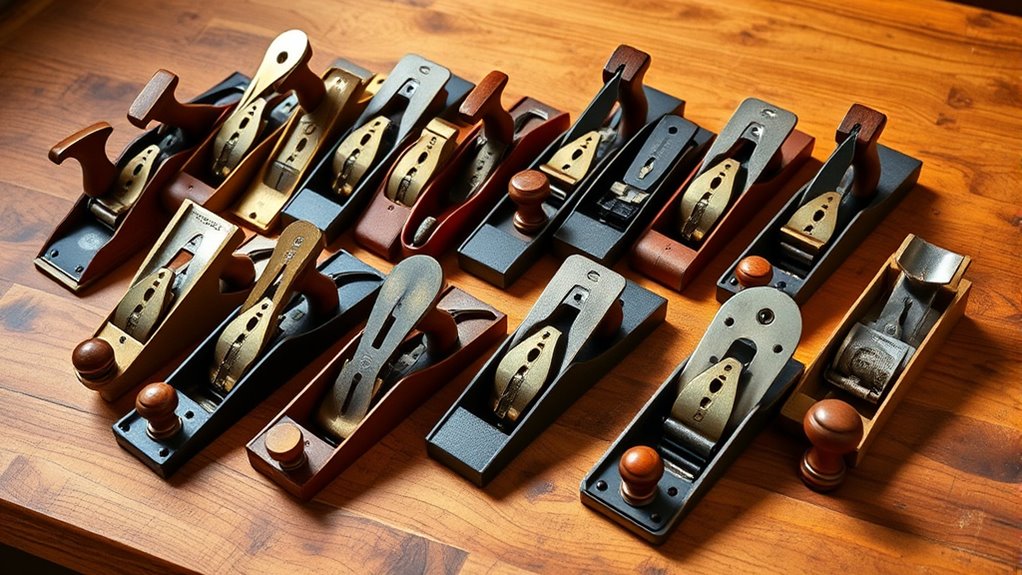Looking for the best woodworking planes to upgrade your carpentry? I recommend exploring a mix of versatile bench planes, mini detailers, and specialized chamfer planes like the Amazon Basics No.4, Jorgensen 3.5 Mini, and the JORGENSEN Chamfer Plane. These options combine quality, durability, and precision for smoothing, shaping, and finishing your projects. Keep exploring the top models to find tools that match your needs and take your woodworking to the next level.
Key Takeaways
- Top-rated planes like the Stanley Bedrock and Amazon Basics No.4 offer precision, durability, and smooth finishes for professional results.
- Versatile models such as the JORGENSEN Chamfer Plane feature interchangeable cutter heads for detailed shaping and edge finishing.
- Compact and lightweight options like Jorgensen 3.5 Mini excel in tight spaces and delicate woodworking projects.
- High-quality materials like cast iron, ductile iron, and high-carbon steel ensure long-lasting performance and stability.
- Proper tuning, sharpening, and maintenance are essential to maximize the effectiveness of these woodworking planes.
Amazon Basics No.4 Adjustable Universal Bench Hand Plane

If you’re looking for an affordable, versatile hand plane for light woodworking tasks, the Amazon Basics No.4 Adjustable Universal Bench Hand Plane is a solid choice. It features a sturdy cast iron body, an impact-resistant plastic handle with a comfortable grip, and a steel alloy blade that delivers smooth cuts. Measuring about 9.8 by 2.5 inches and weighing around 2.7 pounds, it’s easy to handle without fatigue. The tool offers simple adjustments via an adjustable gear and thumb screws, making it suitable for smoothing surfaces or knocking down edges. Despite some initial adjustment challenges, its performance-to-price ratio impresses many DIYers and hobbyists.
Best For: DIYers and hobbyists seeking an affordable, versatile hand plane for light woodworking tasks such as smoothing surfaces and knocking down edges.
Pros:
- Durable cast iron body ensures stability and longevity.
- Easy-to-use adjustable gear and thumb screws facilitate quick blade adjustments.
- Sharp, high-quality blade provides smooth cuts comparable to higher-priced tools.
Cons:
- Adjustment mechanism can be challenging initially, requiring patience.
- Some users report the sole may need flattening for optimal performance.
- Handle and knob sizes can be small, causing discomfort during extended use.
Jorgensen 3.5 Mini Wood Planer for Woodworking
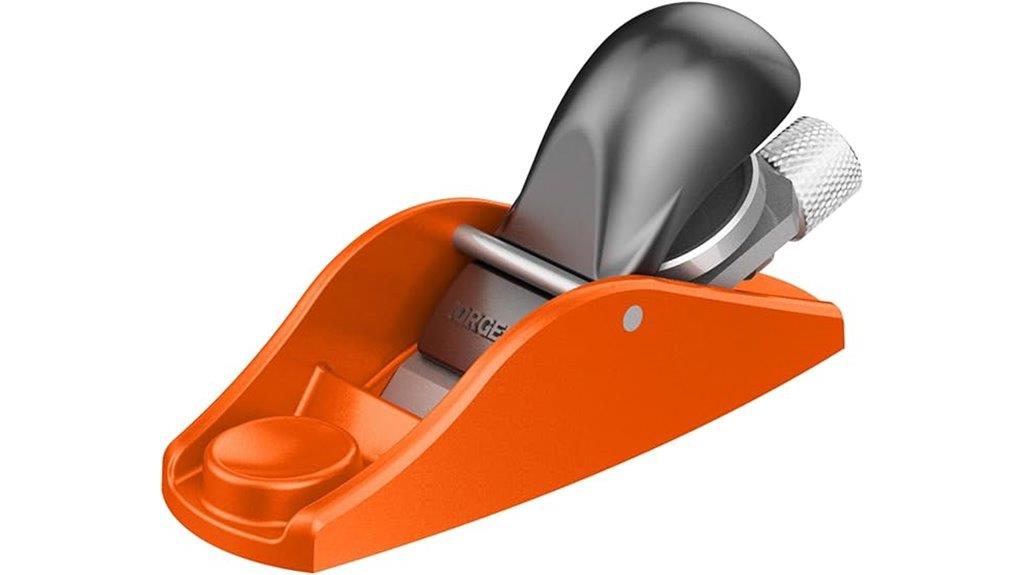
The Jorgensen 3.5 Mini Wood Planer stands out as an ideal tool for woodworking enthusiasts who need precise control in tight spaces or detailed projects. Its compact size—measuring just 3.5 inches—allows easy maneuvering, making it perfect for trimming, polishing, or shaping small wood pieces. Built from durable ductile iron with a polished flat sole, it ensures smooth, accurate cuts. The adjustable depth control and sharp, replaceable blade make fine-tuning straightforward. Whether you’re a hobbyist or professional, this lightweight planer offers reliable performance for intricate work, offering excellent value and control in a small, easy-to-handle package.
Best For: DIY enthusiasts, hobbyists, and professionals needing precise, small-scale woodworking, trimming, and shaping in tight or detailed spaces.
Pros:
- Compact and lightweight for easy handling and maneuverability
- Durable construction with high-quality materials ensuring long-lasting performance
- Adjustable depth control and sharp, replaceable blade for precise cuts and ease of tuning
Cons:
- Slight finickiness in adjusting blade depth may require patience
- Limited to small, detailed projects due to its size and design
- No motor or battery power, relying solely on manual operation
JORGENSEN Chamfer Plane for Woodworking
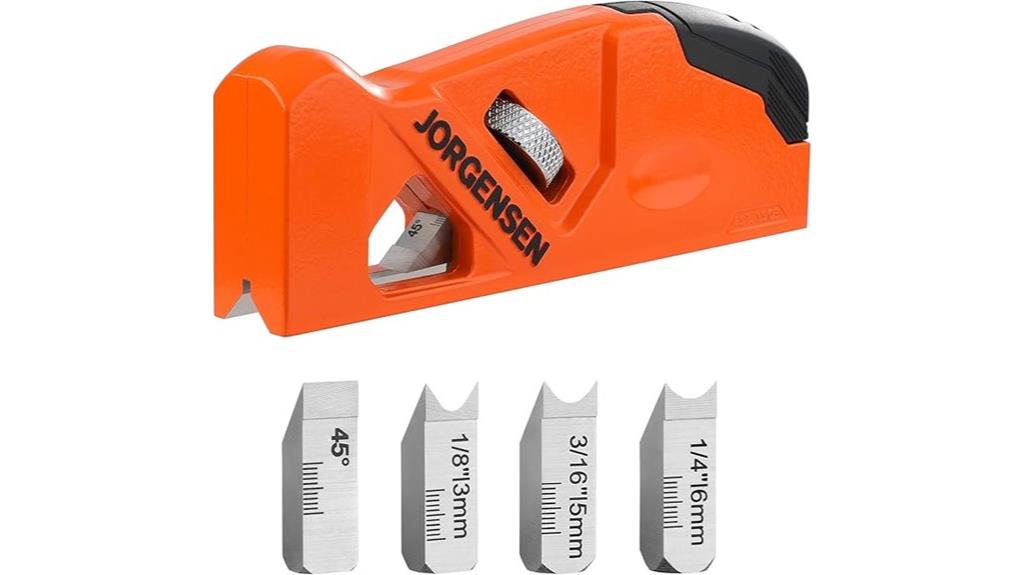
For those seeking precise edge shaping in woodworking, the JORGENSEN Chamfer Plane stands out as a top choice. Its durable aluminum body offers longevity while remaining lightweight and easy to handle. The ergonomic curved exterior, small grip groove, and polished bottom ensure smooth, stain-free operation. It comes with four interchangeable cutter heads—45° flat, 1/4 round, 1/8 round, and 3/16 round—allowing versatile chamfering options. The blades are made of high-quality 9CrWMn steel, providing excellent cutting performance. Adjustable depth control adds precision, making this tool ideal for creating clean edges, rounding, or flattening surfaces on soft and hardwoods alike.
Best For: woodworking enthusiasts and professionals seeking precise edge shaping, chamfering, and surface finishing on soft and hardwoods.
Pros:
- Durable aluminum construction combines sturdiness with lightweight handling
- Four interchangeable cutter heads provide versatile chamfering options
- Adjustable depth control allows for precise, customizable edge smoothing
Cons:
- May require tuning or sharpening for optimal performance out of the box
- Slight difficulty when working with extremely hard woods
- Blade quality can vary, with some users noting initial sharpness could be improved
#5 Bench Hand Plane – Jack Plane -V3
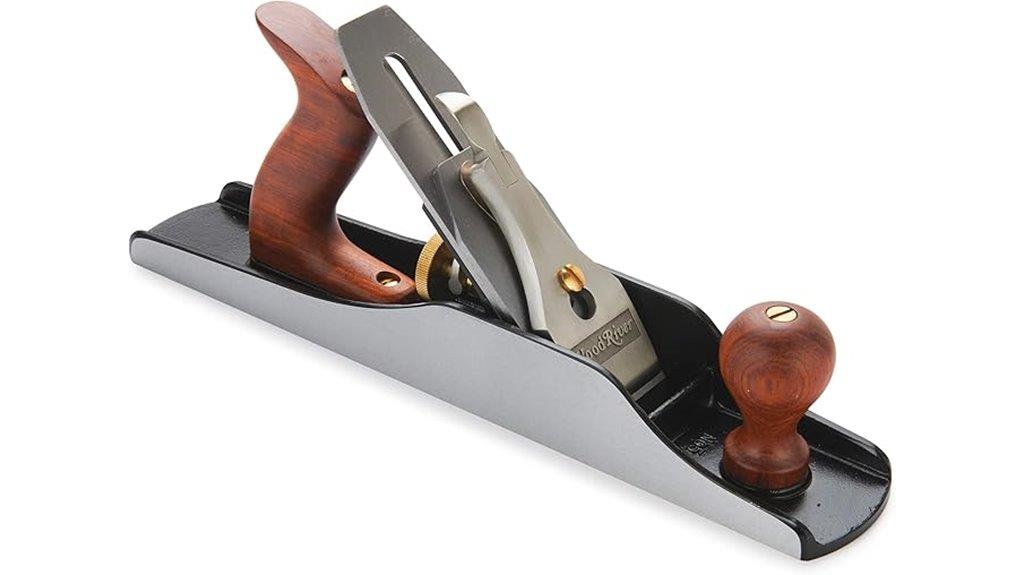
Looking for a dependable bench hand plane that combines traditional design with modern craftsmanship? The #5 Bench Hand Plane – Jack Plane -V3 is inspired by Stanley Bedrock tools, featuring a cast ductile iron body weighing about 6.75 pounds. Its flat machined sole and sides ensure precision, while the lightly finished Bubinga handles provide comfort. Built with heavy castings and fully machined components, it offers stability and durability. Ready to use out of the box, it provides smooth, consistent cuts suitable for both beginners and pros. Priced around $175, it delivers professional performance at a more accessible cost, making it a great addition to any woodworking shop.
Best For: woodworking enthusiasts and professionals seeking a reliable, high-quality bench hand plane that offers precision, durability, and a traditional aesthetic at a more accessible price point.
Pros:
- Crafted with heavy castings and machined components for stability and longevity
- Flat, machined sole and sides ensure excellent precision and smooth operation
- Ready to use out of the box with minimal tuning required
Cons:
- Slight backlash in the lever cap and depth adjuster yoke may require adjustment
- Frog adjustment screws can be difficult to access due to enlarged wheel design
- Some users might prefer finer finishes on certain parts for an even more polished look
Jorgensen 3.5 Mini Wood Planer for Woodworking
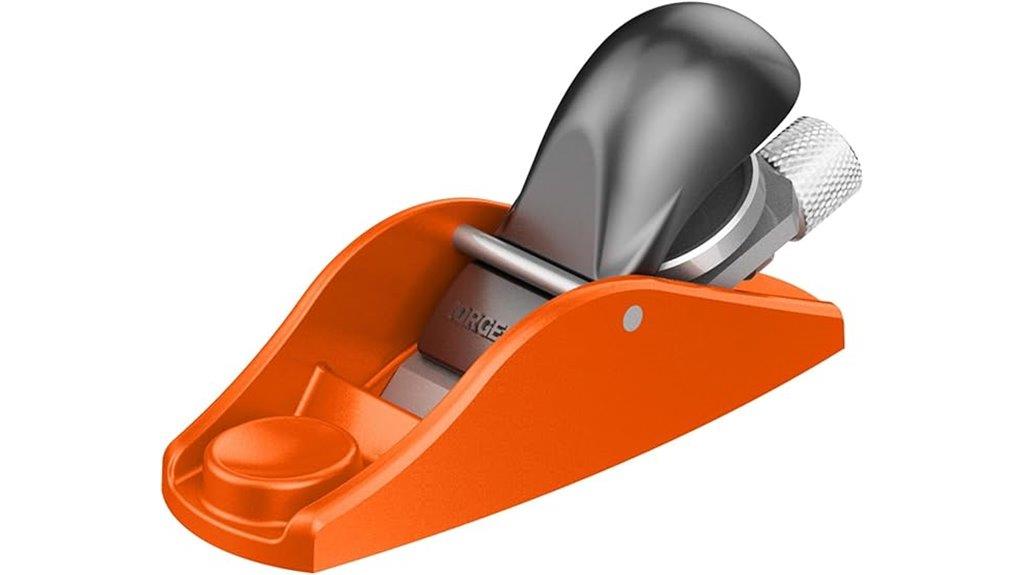
Are you seeking a compact, precise tool perfect for detailed woodworking or tight spaces? The Jorgensen 3.5 Mini Wood Planer is exactly that. Measuring just 3.5 inches long and weighing under 9 ounces, it’s ideal for trimming, polishing, and deburring small projects. Its durable ductile iron body, stainless steel parts, and sharpenable blade ensure long-lasting performance. The adjustable depth control and flat sole give you precision with every shave. Users love its control and ease of use, especially in tight spots or for fine finishing. Whether you’re a hobbyist or pro, this mini planer offers reliable, high-quality results for detailed work.
Best For: hobbyists and professionals seeking a compact, precise tool for detailed woodworking, trimming, and finishing in tight spaces.
Pros:
- Compact and lightweight design for easy handling and access to tight spots
- Durable construction with ductile iron body and sharpenable blade for long-lasting use
- Adjustable cutting depth and flat sole provide precise, smooth cuts
Cons:
- Minor finickiness in adjusting blade depth reported by some users
- Limited to small-scale projects due to its size and power
- No battery operation; manual tool requires consistent manual effort
Amazon Basics No.4 Adjustable Universal Hand Plane
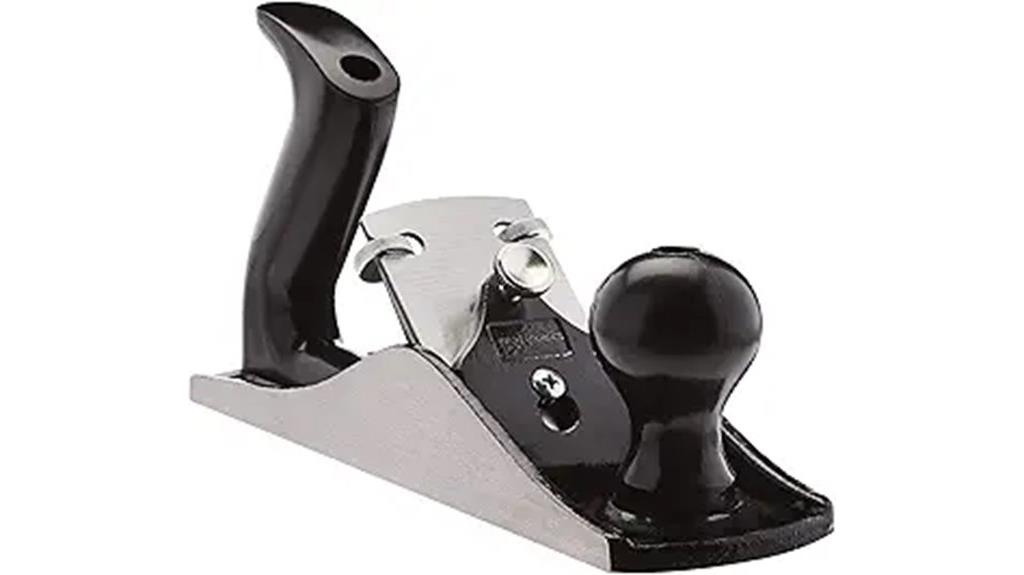
The Amazon Basics No.4 Adjustable Universal Hand Plane stands out as an excellent choice for DIY enthusiasts and hobbyists seeking a reliable, budget-friendly tool for light woodworking tasks. Made with a durable cast iron body and a sharp steel alloy blade, it offers smooth, precise cuts right out of the box. Its adjustable gear and thumb screws make setting blade depth and angle straightforward, though initial adjustments may take patience. Weighing around 2.7 pounds, it’s stable and easy to maneuver, ideal for smoothing surfaces or knocking down edges. Despite some minor build quirks, its high customer rating reflects its value for casual woodworking projects.
Best For: DIY enthusiasts and hobbyists seeking an affordable, reliable hand plane for light woodworking projects.
Pros:
- Sharp steel alloy blade provides smooth, precise cuts right out of the box.
- Easy, stable adjustments with adjustable gear and thumb screws.
- Solid cast iron body ensures durability and stability during use.
Cons:
- Initial adjustment and calibration can be challenging and may require patience.
- Some build imperfections like a slightly uneven sole or small handle size.
- Adjustment mechanisms might feel stiff or require additional fine-tuning for optimal performance.
JORGENSEN No.60-1/2 6-1/4 Mini Wood Planer
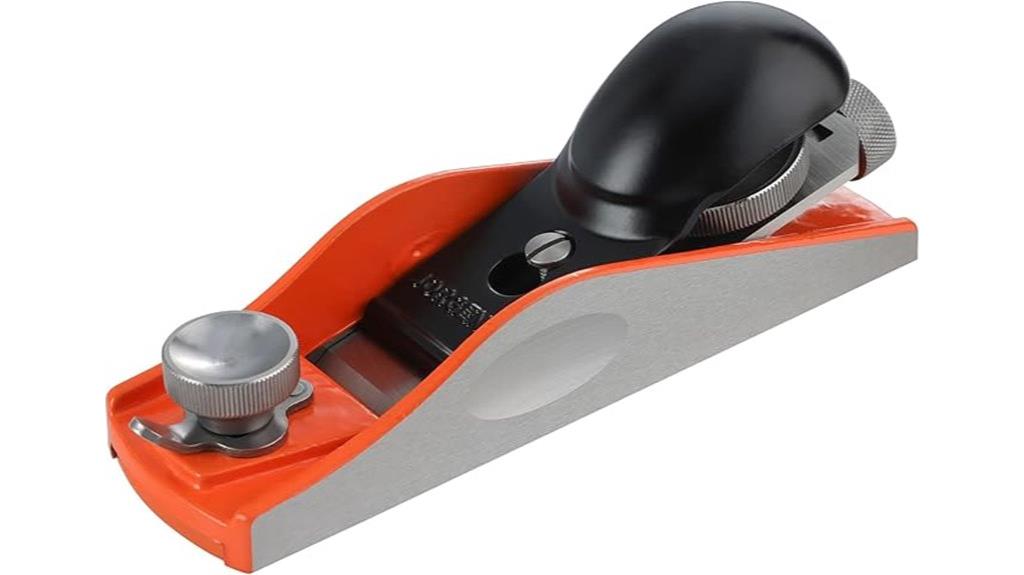
The JORGENSEN No.60-1/2 6-1/4 Mini Wood Planer excels for woodworkers who need a compact, reliable tool for trimming, shaping, and finishing small or detailed projects. Its durable ductile iron body, stainless steel parts, and zinc alloy lever cap ensure lasting strength. The 1.38-inch blade, made from professional-grade 9CrWMn steel, delivers sharp, smooth shavings and can be sharpened repeatedly. With adjustable blade depth and mouth opening, it offers precise control. The polished sole glides smoothly over surfaces, and its ergonomic design provides comfortable handling. Overall, it’s an excellent choice for both DIYers and pros working on fine, detailed work.
Best For: DIYers and professional woodworkers seeking a compact, reliable tool for trimming, shaping, and finishing small or detailed woodworking projects.
Pros:
- Durable construction with ductile iron body and high-quality steel blade for long-lasting performance
- Adjustable blade depth and mouth for precise control over planing tasks
- Smooth operation with a polished sole and ergonomic design for comfortable handling
Cons:
- Initial blade sharpening and sole flattening may be necessary for optimal results
- Some users find blade height adjustments frustrating until properly tuned
- May require extra maintenance to prevent rust and keep the sole flat
Spear & Jackson CJP5 Carpenters No.5 Jack Plane
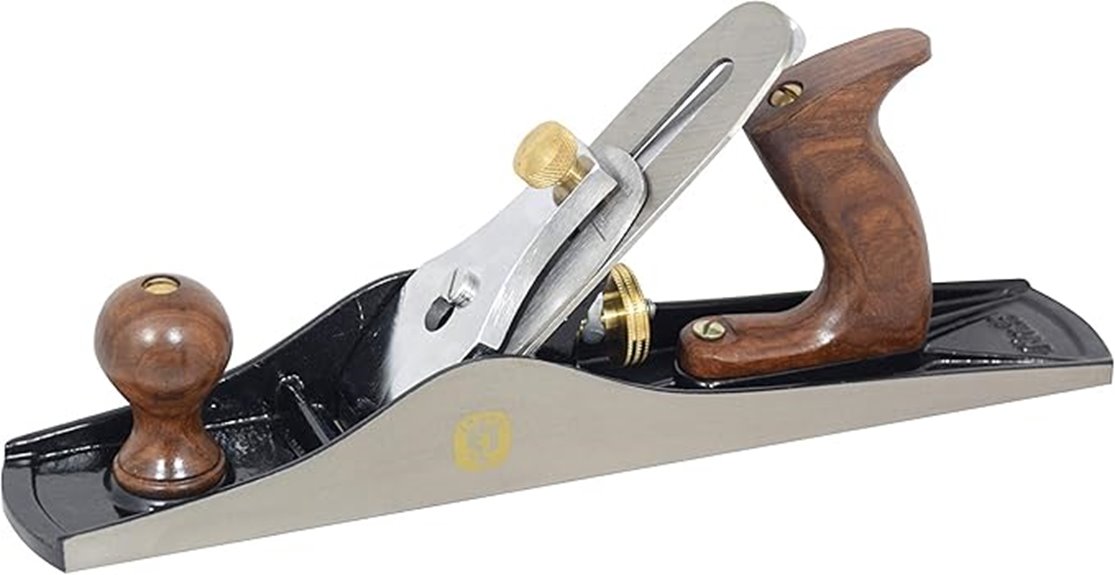
Designed for woodworkers on a budget, the Spear & Jackson CJP5 Carpenters No.5 Jack Plane offers solid construction and versatile performance after some tuning. Its cast iron body and precision-milled base give it durability, while the high carbon steel blade handles rough timber prep effectively. Out of the box, it performs well on softwoods and harder woods with sharp blades, but the sole and machining quality may require sanding and flattening. Adjustments to the mechanisms are often needed to ensure smooth operation. Once tuned, this plane produces thin, consistent shavings, making it a reliable, budget-friendly choice for carpentry projects.
Best For: budget-conscious woodworkers and beginners who are willing to perform some tuning for versatile rough timber preparation.
Pros:
- Solid cast iron construction and durable design
- Performs well on softwoods and harder woods after sharpening and tuning
- Affordable price point suitable for entry-level or learning projects
Cons:
- Requires significant setup work, including flattening the sole and sharpening blades
- Machining quality can be rough, with some issues in sole flatness and component fit
- Packaging and delivery may be inconsistent, with potential delays and minor damage risk
KAKURI Japanese Hand Plane for Woodworking
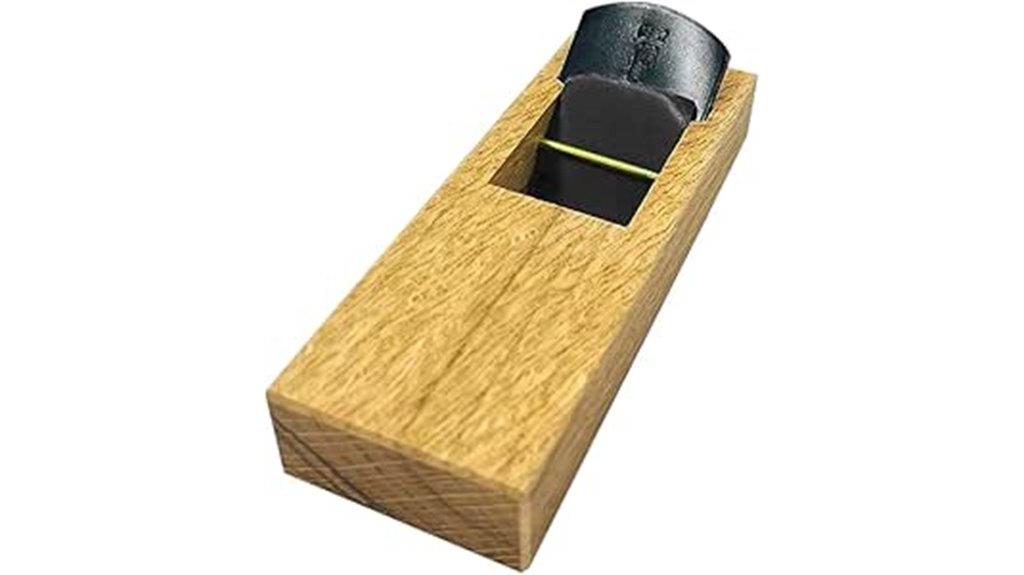
If you’re looking for a versatile and easy-to-handle hand plane, the KAKURI Japanese Hand Plane is an excellent choice, especially for detailed woodworking projects. Its compact design, made from eco-friendly oak, makes it lightweight and comfortable to use. The 42mm high-carbon steel blade offers sharp, smooth cuts with minimal effort, perfect for finishing surfaces and chamfering edges. Unlike Western planes, it’s pulled toward you, giving you more control. Adjustments are simple—just tap the blade with a hammer for precise setup. Priced around $17, it delivers exceptional performance on softwoods and hardwoods, making it a valuable addition to any toolbox.
Best For: DIY enthusiasts and professional woodworkers seeking a lightweight, precise, and affordable hand plane for detailed surface finishing and chamfering.
Pros:
- Easy to adjust and set up with simple tapping, suitable for beginners and pros alike
- Sharp high-carbon steel blade provides smooth, clean cuts with minimal effort
- Compact and lightweight design from eco-friendly oak enhances maneuverability and comfort during extended use
Cons:
- Minor bed alignment adjustments and honing may be required for optimal performance
- Cap iron or chipbreaker can be somewhat flimsy and may need careful handling
- Limited blade size (42mm) may not be ideal for larger planing tasks or heavy stock removal
JORGENSEN Mini Wood Plane for Woodworking
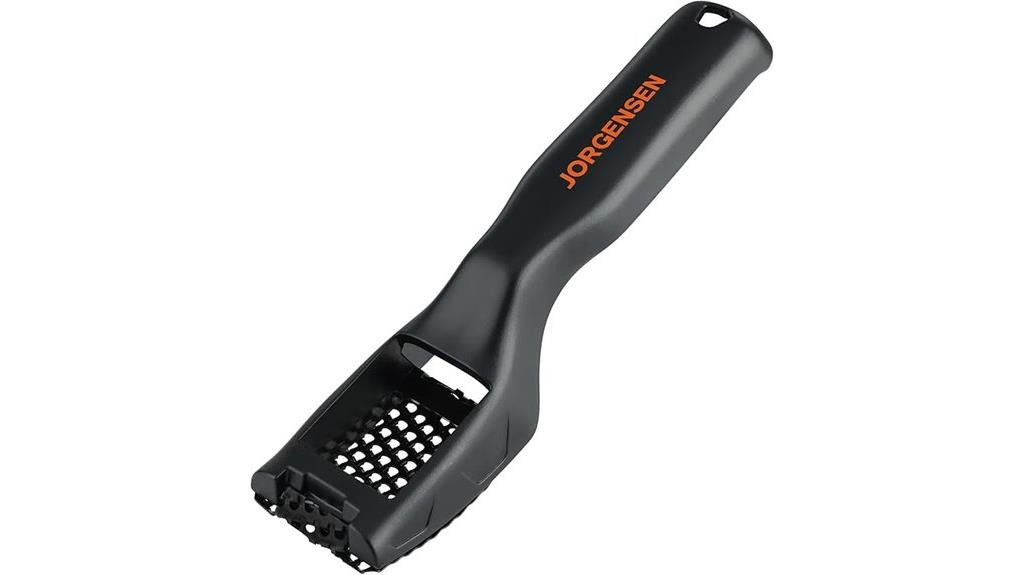
For those working on detailed woodworking projects or small repairs, the JORGENSEN Mini Wood Plane stands out as a portable and precise tool. Its compact design, just over 7 inches long and weighing only 2.39 ounces, makes it easy to handle and store. The sharp, dense saw teeth blade smoothly shaves soft or delicate woods, perfect for tasks like shaving door edges or drawer fronts. Made from durable ABS plastic, it’s sturdy enough for fine adjustments but not suited for heavy-duty work. Its affordability, lightweight build, and replaceable blade make it a practical choice for hobbyists and professionals alike.
Best For: hobbyists and professionals performing detailed woodworking, small repairs, or fine surface adjustments on soft or delicate woods.
Pros:
- Compact and lightweight design for easy handling and storage
- Sharp, dense saw teeth blade for smooth, precise shavings on soft woods
- Affordable with replaceable blades for ongoing use
Cons:
- Not suitable for heavy-duty or large material removal tasks
- Build quality issues reported, such as loose attachments or limited durability
- Less effective on hard, thick, or tougher materials like paint-covered surfaces
Amazon Basics No.4 Adjustable Hand Plane
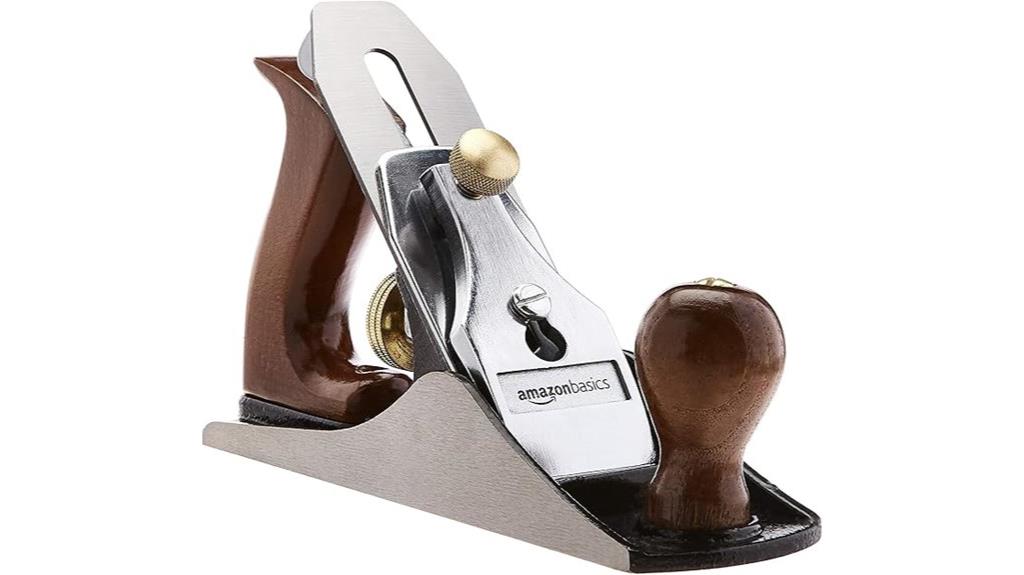
The Amazon Basics No.4 Adjustable Hand Plane is an excellent choice for hobbyists and beginners who want an affordable, functional tool that can be tuned for better performance. Made with a durable cast iron body and impact-resistant handles, it offers stability and comfort during use. The steel alloy blade ensures decent cuts, but it often requires honing or sharpening out of the box. Adjustments can be stiff initially, and some quality control issues like uneven soles or loose handles may arise. With proper tuning, it performs well for smoothing and flattening surfaces. Overall, it’s a budget-friendly option that benefits from user modifications to reach its full potential.
Best For: hobbyists and beginners seeking an affordable, adjustable hand plane that can be tuned for improved woodworking and carpentry projects.
Pros:
- Durable cast iron body provides stability and weight for effective planing
- Fully adjustable for precise control and smoothing surfaces after tuning
- Affordable option that offers good performance with modifications
Cons:
- Initial quality issues such as dull blades and uneven soles may require extensive tuning
- Adjustment mechanisms can be stiff and difficult to operate out of the box
- Some components, like handles and paint, may be loose or misaligned, needing repairs
Wood Turbo Carving Disc (Curve) in 8 Teeth by KOWOOD
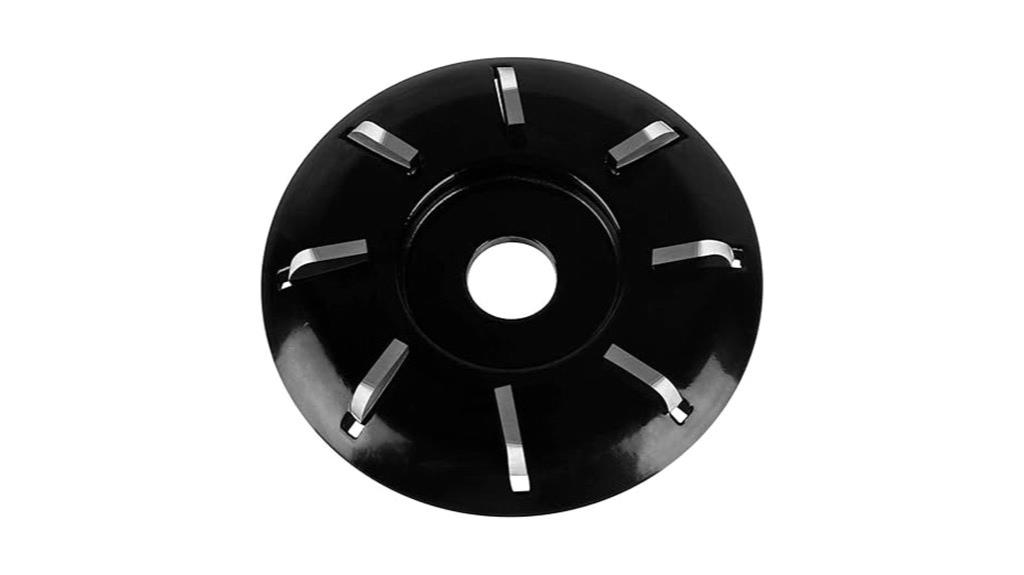
The KOWOOD Wood Turbo Carving Disc (Curve) in 8 Teeth stands out for its rapid and smooth wood milling, making it ideal for professionals and serious DIY enthusiasts seeking precise curve cuts. Its heavy-duty carbide construction guarantees durability and a longer lifespan, even when cutting tough materials like roots and river birch stumps. Compatible with all major angle grinders with a 16mm inner diameter, it minimizes vibration for cleaner, controlled curves that reduce sanding time. I’ve used it on various wood types, including wet wood, and it consistently delivers fast, smooth results. Just remember to wear safety gear and guarantee proper attachment for safe, peak performance.
Best For: professional woodworkers, landscapers, and serious DIYers seeking precise, fast, and durable wood carving and shaping tools.
Pros:
- Heavy-duty carbide construction ensures long-lasting durability and sharpness
- Minimizes vibration for cleaner, more precise curve cuts
- Compatible with all major angle grinders with 16mm inner diameter, versatile for various projects
Cons:
- Some users may face challenges fitting the disk onto certain grinders due to flange nut size
- Requires proper attachment and safety precautions to prevent injuries during operation
- Slightly increased cutting time when working on very wet or tough woods like river birch
Chamfering Machine for Woodworking and Edge Trimming
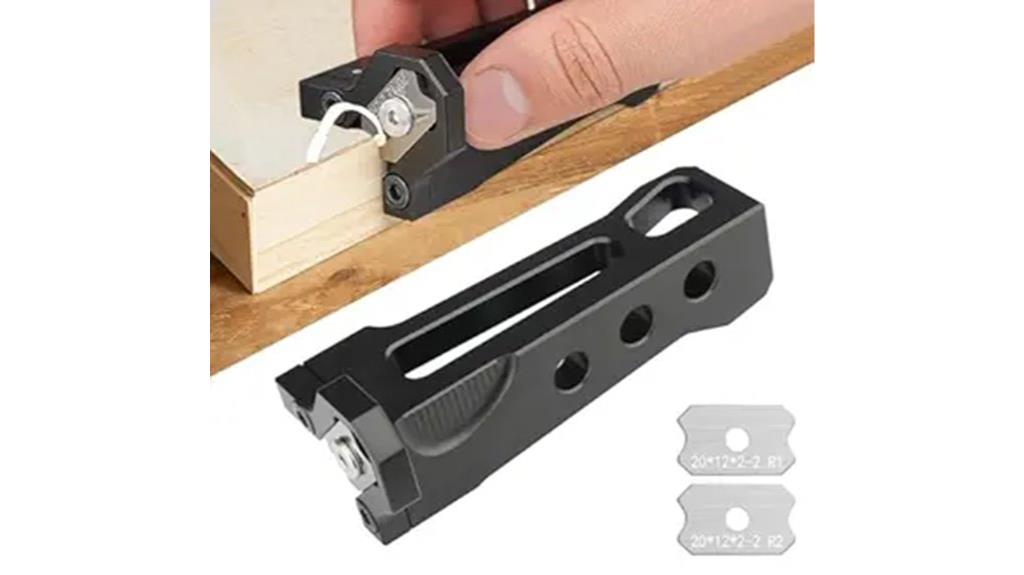
A chamfering machine designed for woodworking and edge trimming offers a compact and safe solution for finishing edges with precision. It features a sturdy construction and replaceable blades, ensuring durability and consistent results. Perfect for trimming excess edge tape on plywood and similar materials, it can both trim and chamfer edges efficiently. While not meant for removing large amounts of material, it excels at creating smooth, professional finishes after trimming. Users find it easy to handle, saving time on projects like cabinets. Overall, this tool is highly recommended for small edge finishing tasks, providing reliable performance and a clean, polished look every time.
Best For: DIY enthusiasts and professional woodworkers seeking a precise, safe, and efficient tool for finishing edges and trimming small amounts of excess material on plywood and similar surfaces.
Pros:
- Compact and lightweight design for easy handling and safety
- High-quality, replaceable blades ensure durability and consistent results
- Efficient at creating smooth, professional edge finishes and chamfers
Cons:
- Not suitable for removing large quantities of material or heavy-duty tasks
- Limited to trimming and finishing, lacking capabilities for shaping or carving
- Requires careful handling to avoid blade dulling or improper trims
Groz Block Plane with Adjustable Mouth

If you need a precise tool for detailed woodworking tasks, the Groz Block Plane with Adjustable Mouth is an excellent choice. Its compact 160mm size makes it perfect for working on end grain, chamfering, and small-scale planing. The flat sole is maintained within 0.003 inches, ensuring smooth operation and accurate cuts. The fully adjustable cutter depth allows me to customize each cut, while the 13.5° blade angle enhances efficiency, especially on end grain. Designed for ease of use and durability, this plane offers precise control and high-quality performance, making it an essential tool for detailed woodworking and fine finishing projects.
Best For: DIY enthusiasts and professional woodworkers who require precise, detailed planing on small projects, especially when working with end grain and fine finishing tasks.
Pros:
- Compact size (160mm) ideal for detailed and precise woodworking tasks
- Fully adjustable cutter depth for customized cuts and control
- Maintains a flat sole within 0.003 inches for smooth, accurate operation
Cons:
- Limited to small-scale planing; not suitable for large surface work
- Blade angle fixed at 13.5°, which may not be ideal for all types of wood or planing needs
- May require regular sharpening and maintenance to sustain precision
Spear & Jackson CSP4 No. 4 Smoothing Plane
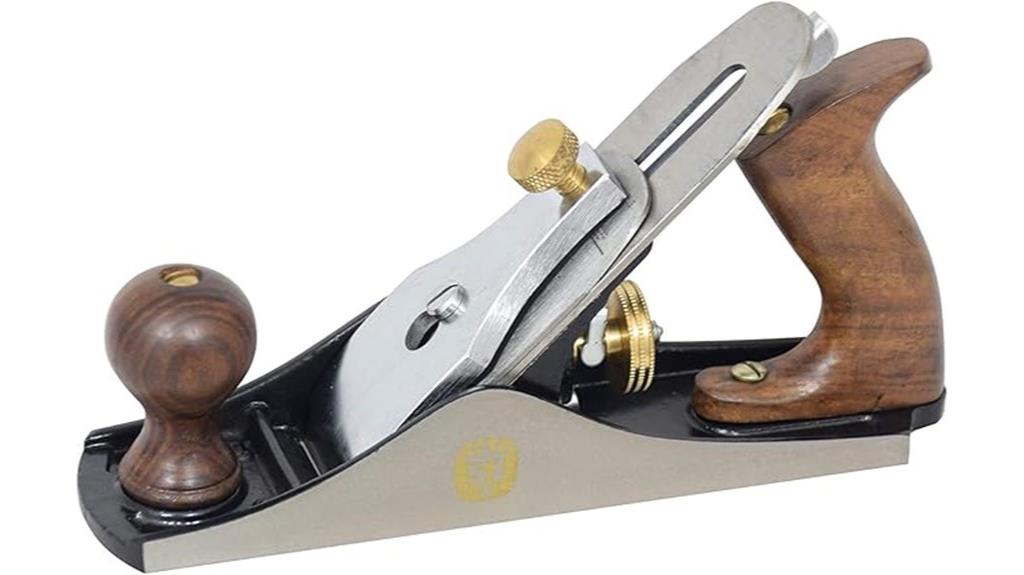
Looking for an affordable smoothing plane that balances quality and value? The Spear & Jackson CSP4 No. 4 is a solid choice for hobbyists and pros alike. With its cast iron body and precision-milled base, it feels sturdy and well-built. The high carbon steel blade can produce fine shavings after some tuning, though the steel may dull quickly and need sharpening. It’s lightweight at around 4 pounds, easy to disassemble, and offers good control once adjusted. While it may require minor work—flattening the sole, tuning the mouth—its low price makes it an excellent entry-level option that, with care, can deliver smooth, professional results.
Best For: hobbyists and professionals seeking an affordable, adjustable smoothing plane for general joinery and cabinet work who are willing to perform minor tuning.
Pros:
- Sturdy cast iron body with precision-milled base provides good stability and control.
- Lightweight at around 4 pounds, easy to handle and disassemble.
- Affordable price point makes it accessible for beginners and budget-conscious users.
Cons:
- Blade steel may dull quickly and require frequent sharpening.
- Adjustment mechanisms like threads and yoke can be loose or poorly machined, needing maintenance.
- Out-of-the-box performance may require tuning such as flattening the sole and tuning the mouth for optimal results.
Factors to Consider When Choosing Woodworking Planes
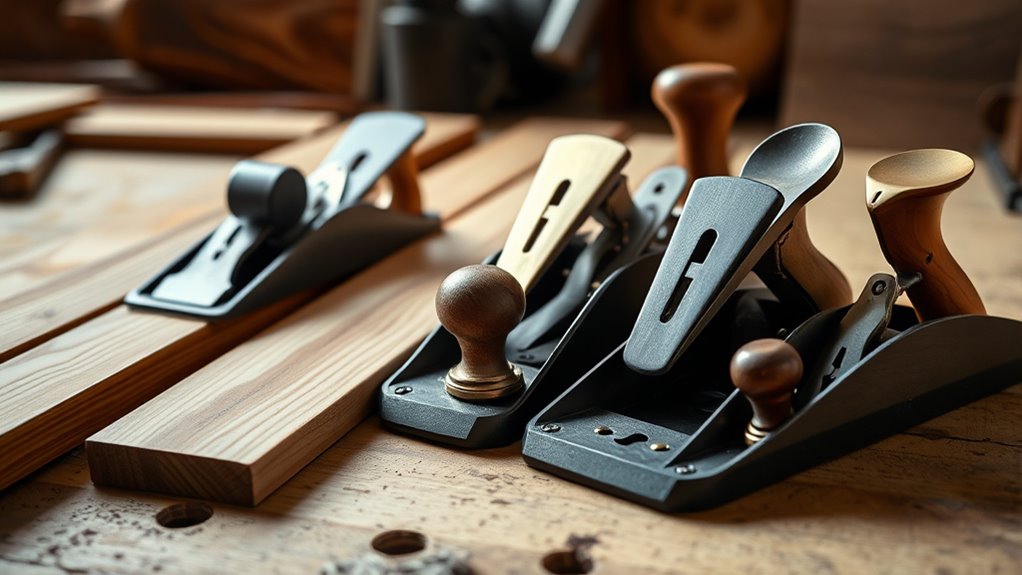
When choosing woodworking planes, I focus on several key factors to guarantee I get the right tool for the job. Things like blade sharpness, adjustability, build quality, size, and ease of setup all influence my decision. Considering these points helps me select a plane that’s comfortable, reliable, and effective for my projects.
Blade Sharpness and Material
Choosing the right blade material is crucial because it directly impacts how well your woodworking plane performs over time. High-carbon steel, O1, and A2 steels are excellent choices since they hold an edge longer and resist dulling, ensuring cleaner, more precise cuts. Proper sharpening techniques, like honing and flattening the bevel, are essential to keep the blade sharp and effective. Softer steels dull quickly and need frequent sharpening, while harder steels, though more durable, can be tougher to sharpen. The thickness of the blade also matters; thicker blades provide better stability and maintain a sharp edge under heavy use. Ultimately, the steel quality and manufacturing process influence how well the blade produces fine shavings and resists chipping during demanding woodworking tasks.
Adjustability and Control
The ability to precisely adjust a woodworking plane is essential for achieving accurate and consistent cuts. Adjustable planes feature mechanisms like thumb screws, gear controls, or vernier wheels, allowing me to set blade depth and angles with precision. The range of adjustment impacts versatility—some planes offer fine-tuned control for detailed work, while others handle broader adjustments for rough shaping. Proper calibration and secure locking prevent blade movement during use, which ensures consistent results and minimizes rework. The quality of adjustment controls—how easy they are to use and resistant to slipping—directly influences my ability to maintain desired settings. With adjustable planes, I can modify blade angles or depths effortlessly, giving me greater control over finishes, from smooth surfaces to specialized cuts.
Build Quality and Durability
Build quality and durability directly influence how well a woodworking plane performs and how long it lasts. High-quality planes are crafted from durable materials like cast iron, ductile iron, or high-grade steel, guaranteeing stability and longevity. The flatness and precision of the sole are vital; well-machined surfaces enable smooth, consistent cuts. Strong, corrosion-resistant components such as steel blades, brass adjustment screws, and stainless steel parts enhance overall durability. A well-built plane also features robust adjustment mechanisms—like threaded yokes and gear systems—that maintain alignment over time. Proper assembly and finishing are essential, with minimal casting flaws, loose parts, or sharp edges, which not only guarantee safe handling but also contribute to the tool’s long-lasting performance.
Size and Weight
Selecting the right woodworking plane involves considering its size and weight to match your specific needs. Smaller planes, under 8 inches, excel at detailed work or trimming tight spots, while larger ones over 14 inches are better for smoothing larger surfaces. The weight also matters: heavier planes (around 4-7 pounds) provide stability and help cut more efficiently with less effort, whereas lighter models (under 3 pounds) offer greater control, ideal for fine, delicate tasks. A well-balanced plane with appropriate weight distribution reduces fatigue during extended use and improves precision. Keep in mind that heavier tools can make planing easier, but may require more effort to maneuver, while lighter tools give you more control but might demand extra exertion for smooth results. Choose a size and weight that feel comfortable and suit your project needs.
Ease of Setup
When choosing a woodworking plane, ease of setup is a crucial factor that can save you time and frustration. A plane with simple, clear adjustment mechanisms lets you tune it quickly without hassle, so you can start working faster. Prefilled, pre-sharpened blades and flat soles mean less preparation before use, saving effort and reducing errors. The ability to easily adjust blade depth and lateral position with minimal tools makes setup straightforward and less time-consuming. Clear instructions and intuitive controls help you calibrate the plane correctly on the first try, avoiding trial and error. A well-designed plane that requires minimal flattening or sharpening right out of the box allows for immediate use, making your workflow smoother and more enjoyable.
Compatibility With Projects
Choosing the right woodworking plane depends heavily on how well it suits the specific demands of your project. I always consider the plane’s size and blade width—smaller block planes are perfect for detailed work, while wider smoothing planes handle larger surfaces. I also check if the plane’s adjustability and blade type match the material’s hardness; high-angle planes work well with hardwoods, and low-angle planes suit softwoods. The plane’s sole and body should fit the workpiece’s shape, especially for curves or delicate surfaces. I guarantee the design supports the task, whether chamfering, flattening, or finishing. Ultimately, I think about the plane’s weight and ergonomics to maintain control and reduce fatigue during extended use. All these factors ensure compatibility with my project’s specific needs.
Maintenance and Tuning
Maintaining and tuning woodworking planes is crucial for achieving precise and smooth results. Regular cleaning, sharpening blades, and flattening soles keep the plane performing at its best. Tuning involves adjusting blade depth, lateral alignment, and mouth opening to suit specific tasks and materials. Fine adjustments, like honing or flattening the blade, sole, or chipbreaker, ensure accuracy and clean cuts. Proper maintenance also involves rust prevention through oiling and correct storage, which extends the lifespan of metal components and preserves cutting efficiency. Initial setup and periodic re-tuning are essential, especially when changing blades or switching between different types of wood. Staying diligent with these steps guarantees your plane remains reliable, functional, and ready to deliver professional-quality results every time you pick it up.
Price and Value
Selecting the right woodworking plane involves balancing price and value to get the best results for your budget. Prices vary widely—from under $20 for basic models to over $400 for high-end, professional-grade tools. Cheaper planes often need tuning, sharpening, or modifications, which can add to the overall cost and effort. Conversely, premium models typically feature better build quality, more precise adjustments, and longer-lasting blades, offering better long-term value. For beginners or hobbyists, budget options can be a good entry point if you’re willing to invest time in setup, but they might not match the performance of pricier options. Ultimately, evaluating the performance-to-cost ratio helps ensure you choose a plane that’s reliable, durable, and suited to your specific needs without overspending.
Frequently Asked Questions
How Do I Determine the Right Size of Woodworking Plane for My Projects?
Choosing the right size of woodworking plane depends on your project needs. I consider the workpiece size and the detail involved. For smoothing large surfaces, I opt for a longer plane like a No. 4 or 5. For fine, detailed work, smaller planes such as a block or rabbet are perfect. I always keep a variety handy so I can match the tool to the task for the best results.
What Safety Precautions Should I Follow When Using Woodworking Planes?
You might think woodworking planes are safe, but I’ve learned the hard way that safety is vital. Always wear eye protection and a dust mask, keep your hands clear of the blade, and guarantee the plane is in good condition. I recommend working in a well-lit area and staying focused. Never rush, and always follow the manufacturer’s instructions—these steps keep me safe and make my projects more enjoyable.
Can I Use a Standard Woodworking Plane for Both Soft and Hardwoods?
You can use a standard woodworking plane for both soft and hardwoods, but I recommend choosing the right blade and adjusting the depth accordingly. Softwoods are easier to surface, so a lighter cut works well. For hardwoods, you’ll want a sharper blade and possibly a finer cut to prevent chipping. Always test on scrap first to verify smooth results, and adjust your technique as needed.
How Do I Maintain and Sharpen My Woodworking Planes Effectively?
They say a sharp tool is a safe tool, and I couldn’t agree more. To maintain and sharpen my woodworking planes, I regularly clean the blades and hone them with a sharpening stone or file. I check for dullness and nicks, adjusting the blade angle as needed. Consistent maintenance guarantees clean, precise cuts and prolongs my tools’ life, making every project smoother and more enjoyable.
Are There Specific Planes Recommended for Beginners Versus Advanced Carpenters?
When choosing planes, I recommend beginners start with a block plane and a jack plane—they’re versatile and easy to handle. For advanced carpenters, I suggest investing in a smoothing plane, a rabbet plane, and specialized spokeshaves for precision work. I find that selecting the right plane depends on your skill level and project needs, but starting simple helps build confidence before tackling more complex tools.
Conclusion
Did you know that using the right woodworking plane can boost your project efficiency by up to 30%? Whether you’re smoothing surfaces or trimming edges, choosing the best plane makes all the difference. I’ve shared my top picks to help elevate your carpentry game. Remember, investing in quality tools not only improves your work but also brings more joy to each project. Let’s get planning and create something amazing!
